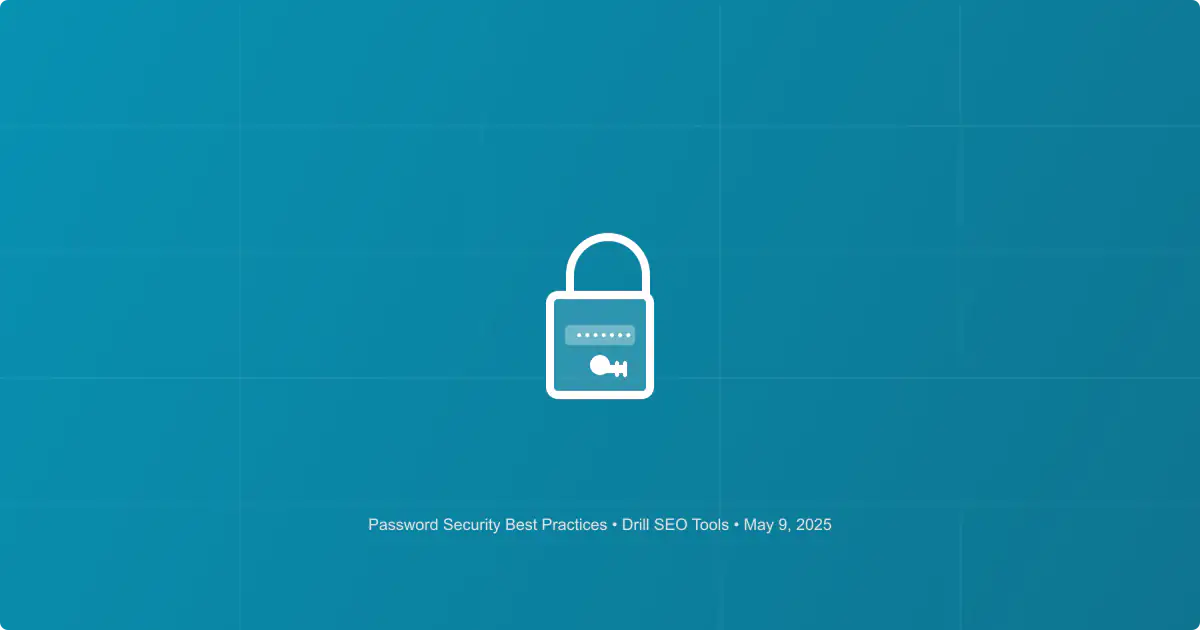Password Security Best Practices for 2025: Beyond the Basics
Learn advanced password security techniques, how to create truly secure passwords, and why password managers are essential in today's digital landscape.

The Evolving Landscape of Password Security
In an era where data breaches have become commonplace, password security is more critical than ever. The average person now manages over 100 online accounts, each ideally requiring a unique, complex password. This digital reality has transformed password creation from a simple task to a significant security challenge.
According to recent cybersecurity reports, credential theft remains the primary vector for data breaches, with over 80% of hacking-related breaches involving compromised or weak passwords. Despite this alarming statistic, many users continue to follow outdated password practices that put their data at risk.
Why Traditional Password Advice Falls Short
For years, standard password advice included creating passwords with:
- At least 8 characters
- A mix of uppercase and lowercase letters
- Numbers and special characters
- No dictionary words
While these guidelines are better than nothing, they're no longer sufficient against modern password-cracking techniques. Today's attackers use sophisticated methods including:
1. Automated Brute Force Attacks
Modern computing power allows attackers to try billions of password combinations per second, making shorter passwords vulnerable regardless of complexity.
2. Dictionary Attacks with Variations
These attacks try common word substitutions (like "p@ssw0rd" instead of "password"), easily cracking passwords that seem complex to humans but follow predictable patterns.
3. Credential Stuffing
Attackers use passwords leaked in previous data breaches to attempt access to other services, exploiting the common habit of password reuse.
2025's Password Security Best Practices
1. Length Trumps Complexity
The most important factor in password strength is length. A longer password, even with simpler characters, is exponentially harder to crack than a short, complex one.
Recommendation: Use passwords that are at least 16 characters long.
2. Use Passphrases
Instead of trying to remember complex strings like "P@s5w0rd!2", use longer passphrases that are easier to remember but harder to crack, such as "correct-horse-battery-staple" or "sunset-mountain-coffee-book".
3. Embrace Randomness
Human-generated "random" passwords often follow unconscious patterns. Use a tool like our Password Generator to create truly random passwords or passphrases.
4. Unique Password for Every Account
Never reuse passwords across different services. If one service is compromised, reused passwords put all your accounts at risk.
5. Use a Password Manager
Password managers generate, store, and autofill strong, unique passwords for all your accounts, solving both the creation and memorization problems.
How Our Password Generator Tool Helps
Our Password Generator tool is designed with modern security standards in mind, offering several advantages:
Truly Random Generation
Unlike human-created passwords, our generator uses cryptographically secure random number generation to create passwords without patterns or biases.
Customizable Security Levels
The tool allows you to adjust password length and character sets based on the security requirements of different accounts.
Passphrase Generation
Beyond traditional passwords, our tool can generate memorable passphrases that combine security with ease of use.
Client-Side Generation
All passwords are generated in your browser - they're never transmitted over the internet or stored on our servers, ensuring complete privacy.
Creating a Password Strategy
Rather than approaching passwords on an account-by-account basis, develop a comprehensive password strategy:
1. Categorize Your Accounts
Divide your accounts into security tiers:
- Critical: Financial, email, and accounts with payment information
- Important: Social media, shopping, and work-related accounts
- Low Priority: Forums, news sites, and other services with minimal personal data
2. Apply Appropriate Security Levels
Adjust your approach based on account importance:
- Critical accounts: 20+ character random passwords, changed every 3-6 months
- Important accounts: 16+ character passwords or passphrases
- Low priority: 12+ character passwords (still unique for each service)
3. Implement Multi-Factor Authentication (MFA)
Whenever possible, enable MFA for an additional layer of security beyond passwords.
Handling Password Resets and Recovery
Even with the best password system, you'll occasionally need to reset passwords:
Secure Recovery Email
Use a dedicated, highly-secured email account for password resets and recovery.
Document Recovery Methods
Maintain an offline, secure record of account recovery methods for critical services.
Backup Authentication Methods
For accounts with MFA, keep backup codes in a secure, offline location.
Special Considerations for Developers
If you're a developer implementing authentication systems:
Never Store Plaintext Passwords
Always hash passwords using modern algorithms like Argon2, bcrypt, or PBKDF2 with sufficient work factors.
Implement NIST Guidelines
Follow the latest NIST password guidelines, which recommend against forced periodic password changes and arbitrary complexity requirements.
Rate Limit Authentication Attempts
Implement progressive delays or temporary lockouts after failed authentication attempts to prevent brute force attacks.
The Future of Authentication
While passwords remain the primary authentication method today, the industry is moving toward more secure alternatives:
Passwordless Authentication
Methods like email magic links, SMS codes, or authenticator apps that don't require remembering passwords.
Biometric Authentication
Fingerprints, facial recognition, and other biometric factors are becoming more common, especially on mobile devices.
Hardware Security Keys
Physical devices that provide cryptographic proof of identity, offering extremely high security for critical accounts.
Conclusion
Password security requires a balanced approach between theoretical security and practical usability. By using tools like our Password Generator, implementing a tiered security strategy, and staying informed about evolving best practices, you can significantly reduce your risk of credential-based attacks.
Remember that perfect security doesn't exist, but with proper password hygiene, you can make your accounts significantly harder to compromise, encouraging attackers to move on to easier targets.
Generate your next secure password with our Password Generator tool and take the first step toward a more secure digital identity.